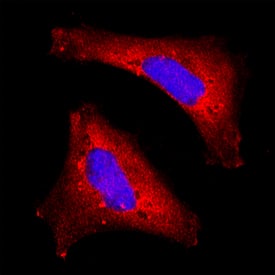Human Dihydrolipoamide Dehydrogenase/DLD Antibody
R&D Systems, part of Bio-Techne | Catalog # MAB8646

Key Product Details
Species Reactivity
Human
Applications
Immunocytochemistry, Immunohistochemistry
Label
Unconjugated
Antibody Source
Monoclonal Mouse IgG2B Clone # 1016619
Product Specifications
Immunogen
E. coli-derived human Dihydrolipoamide Dehydrogenase/DLD
Ala36-Phe509
Accession # P09622
Ala36-Phe509
Accession # P09622
Specificity
Detects human Dihydrolipoamide Dehydrogenase/DLD in direct ELISAs.
Clonality
Monoclonal
Host
Mouse
Isotype
IgG2B
Scientific Data Images for Human Dihydrolipoamide Dehydrogenase/DLD Antibody
Dihydrolipoamide Dehydrogenase/DLD in HeLa Human Cell Line.
Dihydrolipoamide Dehydrogenase/DLD was detected in immersion fixed HeLa human cervical epithelial carcinoma cell line using Mouse Anti-Human Dihydrolipoamide Dehydrogenase/DLD Monoclonal Antibody (Catalog # MAB8646) at 8 µg/mL for 3 hours at room temperature. Cells were stained using the NorthernLights™ 557-conjugated Anti-Mouse IgG Secondary Antibody (red; Catalog # NL007) and counterstained with DAPI (blue). Specific staining was localized to cytoplasm. View our protocol for Fluorescent ICC Staining of Cells on Coverslips.Dihydrolipoamide Dehydrogenase/DLD in Human Liver Tissue.
Dihydrolipoamide Dehydrogenase/DLD was detected in immersion fixed paraffin-embedded sections of human liver tissue using Mouse Anti-Human Dihydrolipoamide Dehydrogenase/DLD Monoclonal Antibody (Catalog # MAB8646) at 5 µg/mL for 1 hour at room temperature followed by incubation with the Anti-Mouse IgG VisUCyte™ HRP Polymer Antibody (Catalog # VC001). Before incubation with the primary antibody, tissue was subjected to heat-induced epitope retrieval using Antigen Retrieval Reagent-Basic (Catalog # CTS013). Tissue was stained using DAB (brown) and counterstained with hematoxylin (blue). Specific staining was localized to cytoplasm and nuclei in hepatocytes. View our protocol for IHC Staining with VisUCyte HRP Polymer Detection Reagents.Applications for Human Dihydrolipoamide Dehydrogenase/DLD Antibody
Application
Recommended Usage
Immunocytochemistry
5-25 µg/mL
Sample: Immersion fixed HeLa human cervical epithelial carcinoma cell line
Sample: Immersion fixed HeLa human cervical epithelial carcinoma cell line
Immunohistochemistry
5-25 µg/mL
Sample: Immersion fixed paraffin-embedded sections of human liver tissue
Sample: Immersion fixed paraffin-embedded sections of human liver tissue
Formulation, Preparation, and Storage
Purification
Protein A or G purified from hybridoma culture supernatant
Reconstitution
Reconstitute at 0.5 mg/mL in sterile PBS. For liquid material, refer to CoA for concentration.
Formulation
Lyophilized from a 0.2 μm filtered solution in PBS with Trehalose. *Small pack size (SP) is supplied either lyophilized or as a 0.2 µm filtered solution in PBS.
Shipping
Lyophilized product is shipped at ambient temperature. Liquid small pack size (-SP) is shipped with polar packs. Upon receipt, store immediately at the temperature recommended below.
Stability & Storage
Use a manual defrost freezer and avoid repeated freeze-thaw cycles.
- 12 months from date of receipt, -20 to -70 °C as supplied.
- 1 month, 2 to 8 °C under sterile conditions after reconstitution.
- 6 months, -20 to -70 °C under sterile conditions after reconstitution.
Background: Dihydrolipoamide Dehydrogenase/DLD
References
- Brand, M.D. (2010) Exp. Gerontol. 45:466.
- Johnson, M.T. et al. (1997) Proc. Natl. Acad. Sci. USA 94:14512.
- Sundquist, A.R. and R.C. Fahey (1988) J. Bacteriol. 170:3459.
- Ambrus, A. et al. (2011) Hum. Mol. Genet. 20:2984.
- Vaubel, R.A. et al. (2011) J. Biol. Chem. 286:40232.
- Babady, N.E. et al. (2007) Proc. Natl. Acad. Sci. USA 104:6158.
- Calingasan, N.Y. et al. (2008) Neuroscience 153:986.
- Panneerdoss, S. et al. (2012) J. Androl. 33:699.
- Schlipalius, D.I. et al. (2012) Science 338:807.
Alternate Names
Diaphorase, DLD, DLDD, DLDH, GCSL, LAD, Lipoamide Dehydrogenase, PHE3
Gene Symbol
DLD
UniProt
Additional Dihydrolipoamide Dehydrogenase/DLD Products
Product Documents for Human Dihydrolipoamide Dehydrogenase/DLD Antibody
Product Specific Notices for Human Dihydrolipoamide Dehydrogenase/DLD Antibody
For research use only
